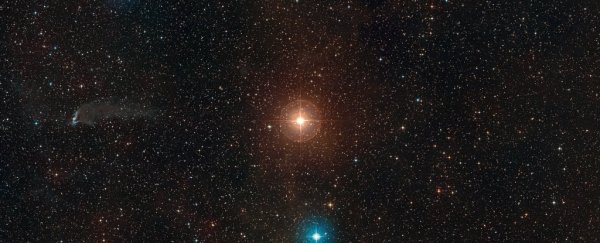A red giant star 16,000 light-years away appears to be a bona fide member of just the second generation of stars in the Universe.
According to an analysis of its chemical abundances, it seems to contain elements produced in the life and death of just a single first-generation star. Therefore, with its help, we might even find the first generation of stars ever born - none of which have yet been discovered.
Additionally, the researchers performed their analysis using photometry, a technique that measures the intensity of light, thus offering a new way to find such ancient objects.
"We report the discovery of SPLUS J210428.01−004934.2 (hereafter SPLUS J2104−0049), an ultra-metal-poor star selected from its narrow-band S-PLUS photometry and confirmed by medium- and high-resolution spectroscopy," the researchers wrote in their paper.
"These proof-of-concept observations are part of an ongoing effort to spectroscopically confirm low-metallicity candidates identified from narrow-band photometry."
Although we feel like we have a pretty good grasp of how the Universe grew from the Big Bang to the star-studded glory we know and love today, the first stars to turn on their blinking lights in the primordial darkness, known as Population III stars, remain something of a mystery.
Current day star-formation processes give us some clues about how these early stars came together, but until we find them, we're basing our understanding on incomplete information.
One trail of breadcrumbs are the Population II stars - the next few generations following Population III. Of those, the generation immediately succeeding Population III are perhaps the most exciting, since they are the closest in composition to Population III.
We can identify them by their extremely low abundance of elements like carbon, iron, oxygen, magnesium and lithium, detected by analysing the spectrum of light emitted by the star, which contains the chemical fingerprints of the elements therein.
That's because, before stars came into existence, there were no heavy elements - the Universe was a sort of cloudy soup of mostly hydrogen and helium. When the first stars formed, this is what they ought to have been made of, too - it's via the process of thermonuclear fusion in their cores that the heavier elements were formed.
First, hydrogen is fused into helium, then helium into carbon, and so forth all the way down to iron, depending on the mass of the star (the smallest ones don't have enough energy to fuse helium into carbon, and end their lives when they reach that point). Even the most massive stars don't have enough energy to fuse iron; when their core is entirely iron, they go supernova.
These colossal cosmic explosions spew all that fused material out into nearby space; in addition, the explosions are so energetic, they generate a series of nuclear reactions that forge even heavier elements, such as gold, silver, thorium and uranium. Baby stars then forming from clouds that contain these materials have higher metallicity than the stars that came before.
Today's stars - Population I - have the highest metallicity. (By-the-by, this does mean that eventually no new stars will be able to form, since the Universe's hydrogen supply is finite - good times.) And stars that were born when the Universe was very young have very low metallicity, with the earliest stars known as ultra-metal-poor stars or UMP stars.
These UMPs are considered bona fide Population II stars, enriched by material from just a single Population III supernova.
Using a photometric survey called S-PLUS, a team of astronomers led by the National Science Foundation's NOIRLab identified SPLUS J210428-004934, and although it doesn't have the lowest metallicity we've detected yet (that honor belongs to SMSS J0313-6708), it has an average metallicity for a UMP star.
It also has the lowest carbon abundance astronomers have ever seen in an ultra-metal-poor star. This could give us an important new constraint on the progenitor star and stellar evolution models for very low metallicities, the researchers said.
To figure out how the star could have formed, they performed theoretical modeling. They found the chemical abundances observed in SPLUS J210428-004934, including the low carbon and the more normal UMP star abundances of other elements, could best be reproduced by a high-energy supernova of a single Population III star 29.5 times the mass of the Sun.
However, the closest fits from the modeling still were unable to produce enough silicon to exactly replicate SPLUS J210428-004934. They recommended looking for more ancient stars with similar chemical properties to try to resolve this strange discrepancy.
"Additional UMP stars identified from S-PLUS photometry will greatly improve our understanding of Pop III stars and enable the possibility of finding a metal-free low-mass star still living in our Galaxy today," the researchers wrote.
Their paper has been published in The Astrophysical Journal Letters.
